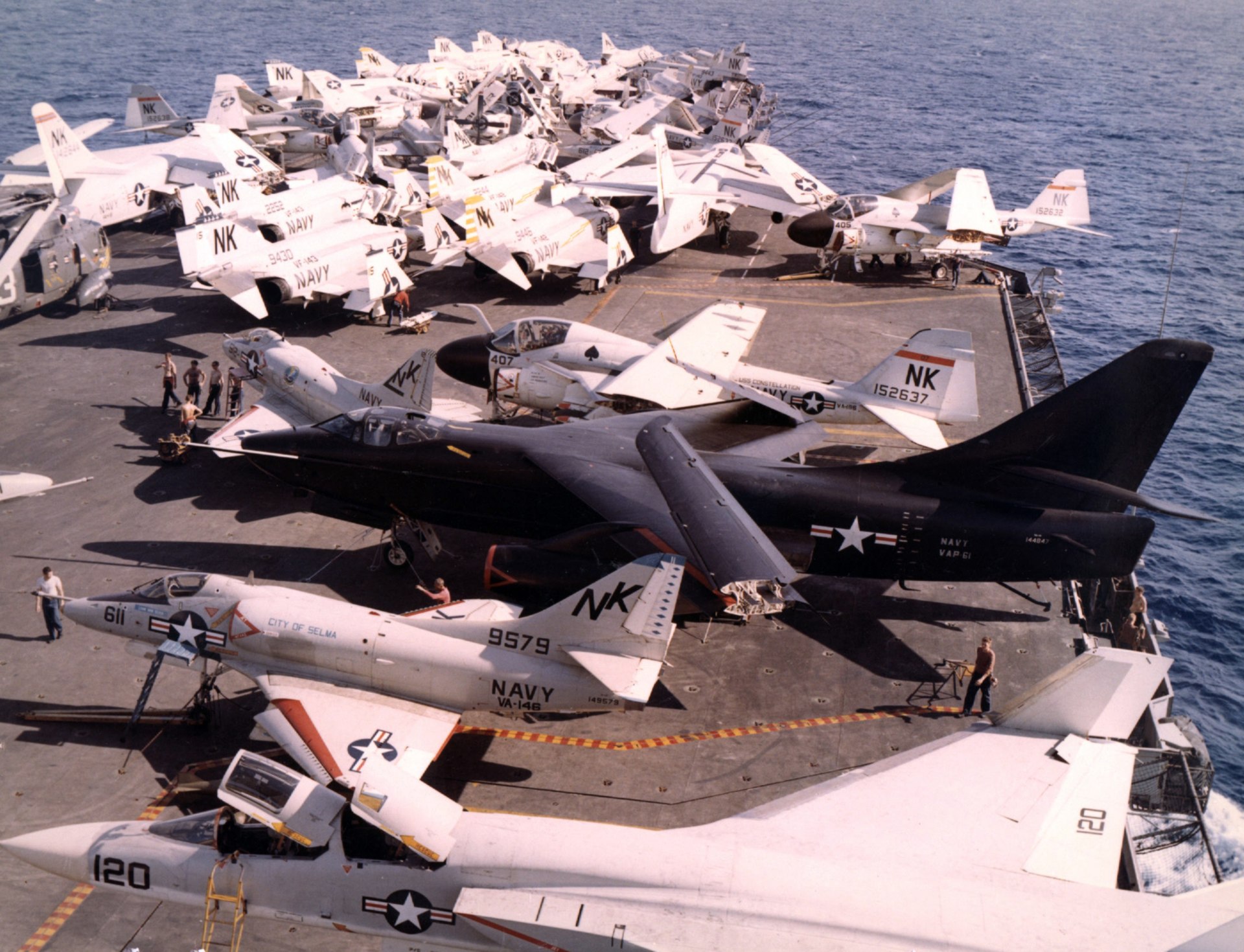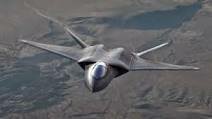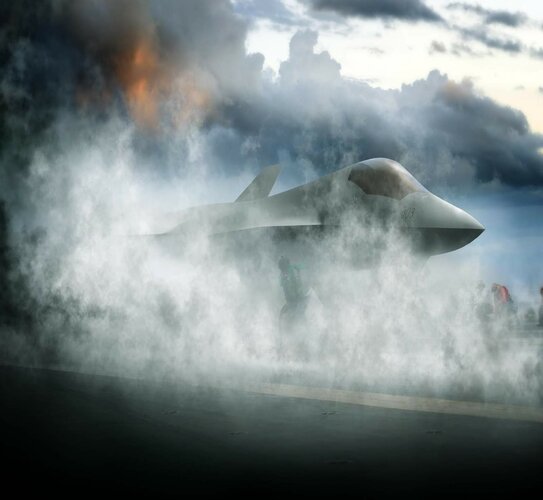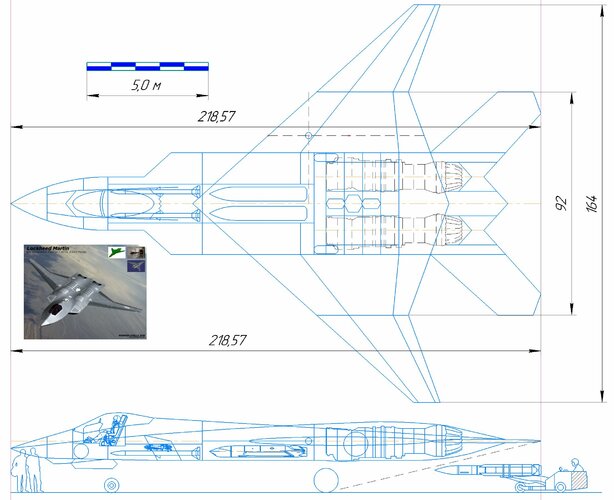I took it to mean they are going for off the shelf tech to truncate development time and cost. I believe the B-21 was designed in a similar fashion. Whatever results from that program, it will be one of the first USAF aircraft programs that’s on time and budget in my lifetime.
You are using an out of date browser. It may not display this or other websites correctly.
You should upgrade or use an alternative browser.
You should upgrade or use an alternative browser.
USAF/USN 6th Gen Fighters - F/A-XX, F-X, NGAD, PCA, ASFS News & Analysis
- Thread starter Matej
- Start date
- Status
- Not open for further replies.
- Joined
- 21 April 2009
- Messages
- 13,762
- Reaction score
- 7,706

New Skunk Works Plant to Build Advanced Fighters, Other Projects | Air & Space Forces Magazine
Lockheed Martin has finished building a massive new factory for its Skunk Works division to work on advanced development projects.
Here also

 www.aero-mag.com
www.aero-mag.com

Skunk Works and Spirit unveil game-changing assembly technique
Using advanced digital manufacturing technology and robotic assembly, Lockheed Martin’s Skunk Works and Spirit AeroSystems have nearly doubled initial quality of assembly.
Last edited:
- Joined
- 21 April 2009
- Messages
- 13,762
- Reaction score
- 7,706
Opinion: Key Questions About USAF’s NGAD Sixth-Gen Aircraft Program | Aviation Week Network
Is there a flying aircraft, and who is the prime contractor? What about timing and numbers procured?
jsport
what do you know about surfing Major? you're from-
- Joined
- 27 July 2011
- Messages
- 7,742
- Reaction score
- 5,761

A US Air Force war game shows what the service needs to hold off — or win against — China in 2030
American officials talked about the classified war game’s results with Defense News, just months before the service planned to release its fiscal 2022 budget.
The recipe is known, the US and NATO always use it. When the army has no "Fighting Spirit", quantitative superiority is used. Try to surpass China in this 
Operation "Allied Force". NATO - 1031 aircraft, Yugoslavia 14 combat-ready MiG-29[4] and 34 serviceable MiG-21, NATO superiority by 21 times The 2003 Iraq War, NATO 1801 aircraft, Iraq serviceable no more than 50-MiG-23, MiG-25 and MiG-29. NATO superiority-36 times
Operation "Allied Force". NATO - 1031 aircraft, Yugoslavia 14 combat-ready MiG-29[4] and 34 serviceable MiG-21, NATO superiority by 21 times The 2003 Iraq War, NATO 1801 aircraft, Iraq serviceable no more than 50-MiG-23, MiG-25 and MiG-29. NATO superiority-36 times
- Joined
- 28 January 2008
- Messages
- 1,019
- Reaction score
- 2,211
The Navy needs a good mix of aircraft again like when I was in and on CVN-65 (F-14, A-6, EA-6, S-3, E-2, A-7). A good naval mission air superiority fighter (similar to the Tomcat) but you now have the strike fighter assets now (F-35, F/A-18) for their roles like the USAF F-16. MQ-25, I'm on the ropes regarding this one but the Navy has always needed a good, purpose built tanker, don't know if MQ-25 is it though. No USN and USAF sharing a common fighter design derivative, different missions.
The US Navy Is Reversing Its Fighter-Jet Design Philosophy
NavAir commander says the next-gen plane will be designed around certain cutting-edge technologies.www.defenseone.com
Sounds like they can't afford the plane.
isayyo2
Lurker alert
- Joined
- 24 November 2011
- Messages
- 1,131
- Reaction score
- 2,331
At least with MQ-25 we're not burning Super Hornet hours on buddy refueling, they're piloted by Warrant Officers to boot. I do hope they explore further payloads beyond the tanking gear and internal ISR gear too. What's still needed unfortunately is a S-3 replacement, multipurpose and long duration maritime patrol aircraft organic to the Battlegroup. Leverage development from the P-8s with sized down APS-154 MTI/ISAR system and operator consoles to control drones. Maybe based off the E-2 ASW concepts of yesteryear?The Navy needs a good mix of aircraft again like when I was in and on CVN-65 (F-14, A-6, EA-6, S-3, E-2, A-7). A good naval mission air superiority fighter (similar to the Tomcat) but you now have the strike fighter assets now (F-35, F/A-18) for their roles like the USAF F-16. MQ-25, I'm on the ropes regarding this one but the Navy has always needed a good, purpose built tanker, don't know if MQ-25 is it though. No USN and USAF sharing a common fighter design derivative, different missions.
The US Navy Is Reversing Its Fighter-Jet Design Philosophy
NavAir commander says the next-gen plane will be designed around certain cutting-edge technologies.www.defenseone.com
Sounds like they can't afford the plane.
- Joined
- 2 August 2006
- Messages
- 3,256
- Reaction score
- 1,529
NavAir commander says the next-gen plane will be designed around certain cutting-edge technologies.
The U.S. Navy plans to design a new-generation fighter jet around different types of technology—as opposed to designing an aircraft and then trying to pack it with technology after the fact, a top admiral said.
Vice Adm. Dean Peters, the Naval Air Systems Command commander, described a shift in the design philosophy of high-performance fighter jets.
“The most important thing that's going to happen with this with Next Generation [Air Dominance] is that we're going to take all of those technologies that we've developed, those enabling technologies, and instead of picking a platform and then figuring out how to wedge those enabling technologies into it, or not be able to wedge those into it, we're gonna start with the enabling technologies, and make that part of the criteria for what the aircraft looks like on the other end,” Peters said at the Navy League’s Sea Air Space convention in National Harbor, Maryland.
Called the Next Generation Air Dominance, or NGAD, the plane is to eventually replace the aircraft carrier-based F/A-18 Super Hornet. The Air Force also has a next-generation fighter jet project by the same name.
“I can tell you that although...the program is different than the Air Force, there is a very tight integration between the Air Force and the Navy, or what this platform is going to be,” Peters said.

The US Navy Is Reversing Its Fighter-Jet Design Philosophy
NavAir commander says the next-gen plane will be designed around certain cutting-edge technologies.www.defenseone.com
I had no idea the Navy has been designing airplanes incorrectly all of these years, as what he is talking about is exactly how I was taught to design aircraft decades ago. Well, that certainly explains the Super Hornet.
Bhurki
ACCESS: Secret
- Joined
- 16 July 2020
- Messages
- 345
- Reaction score
- 382
He has to make it sound distinct, new and exciting to secure funds or he might get stuck with an F35, or an NGAD derivative with canards.I had no idea the Navy has been designing airplanes incorrectly all of these years, as what he is talking about is exactly how I was taught to design aircraft decades ago. Well, that certainly explains the Super Hornet.

Four questions with the head of Air Combat Command
Gen. Mark Kelly talked about the service's sixth-generation fighter and plans to replace the E-3 airborne warning and control plane, better known as the AWACS.
dark sidius
ACCESS: Top Secret
- Joined
- 1 August 2008
- Messages
- 1,200
- Reaction score
- 1,075
We can expect to see something realy different with this program.
- Joined
- 21 January 2015
- Messages
- 12,169
- Reaction score
- 16,395
Out of interest just who decides what should and shouldn’t be disclosed about a program, do they loop the president in on such decisions or is it just the senior brass in the USAF?
Four questions with the head of Air Combat Command
Gen. Mark Kelly talked about the service's sixth-generation fighter and plans to replace the E-3 airborne warning and control plane, better known as the AWACS.www.defensenews.com
What does it say about things when us in the U.K. and Australia will be operating a far more up to date airframe for our AWACS requirements.
shin_getter
ACCESS: Top Secret
- Joined
- 1 June 2019
- Messages
- 1,117
- Reaction score
- 1,508
Hmm, a Idea just hit me.
Given that 6th gen may not have traditional aerodynamic control surfaces for stealth reasons, with control dependent on thrust vectoring and blown air methods....
Perhaps 6th gen can support near zero velocity post-stall (tail-sitting) landing/takeoff operations with only a small design change? With effective means of low speed control and Thrust to weight ratio >>1 (likely at low fuel states).
It seems not too difficult to manage a near zero velocity tail sit touch down with modern controls, the actually tricky part is how to get the aircraft horizontal on the ground again. A propulsor to lift/gently drop the nose and specially designed landing gear could do the job.
Not like visibility is a issue in the era of virtual cockpits necessary to deal with lasers.
Not sure if this sort of operation would be considered reliable enough for navy use.
Given that 6th gen may not have traditional aerodynamic control surfaces for stealth reasons, with control dependent on thrust vectoring and blown air methods....
Perhaps 6th gen can support near zero velocity post-stall (tail-sitting) landing/takeoff operations with only a small design change? With effective means of low speed control and Thrust to weight ratio >>1 (likely at low fuel states).
It seems not too difficult to manage a near zero velocity tail sit touch down with modern controls, the actually tricky part is how to get the aircraft horizontal on the ground again. A propulsor to lift/gently drop the nose and specially designed landing gear could do the job.
Not like visibility is a issue in the era of virtual cockpits necessary to deal with lasers.
Not sure if this sort of operation would be considered reliable enough for navy use.
- Joined
- 21 April 2009
- Messages
- 13,762
- Reaction score
- 7,706
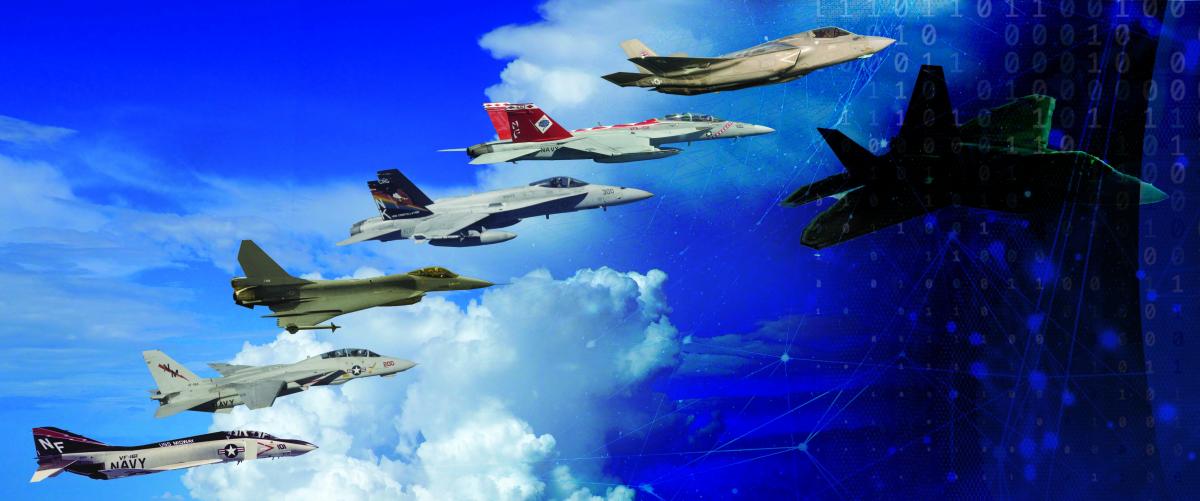
Next Generation Air Dominance Needs A New Flight Path
If the Pentagon switches course, NGAD can be cheaper, better, and faster than anything China or Russia can produce.
- Joined
- 21 April 2009
- Messages
- 13,762
- Reaction score
- 7,706
Do you want a fighter or a lunar lander that will spend half its time undergoing repairs? I would prefer a plane with a high readiness rate and not weighted down with 7,000 lbs of thrust vectoring plumbing. Maybe one day they will discover the element 115 isotope for vtol opsHmm, a Idea just hit me.
Given that 6th gen may not have traditional aerodynamic control surfaces for stealth reasons, with control dependent on thrust vectoring and blown air methods....
Perhaps 6th gen can support near zero velocity post-stall (tail-sitting) landing/takeoff operations with only a small design change? With effective means of low speed control and Thrust to weight ratio >>1 (likely at low fuel states).
It seems not too difficult to manage a near zero velocity tail sit touch down with modern controls, the actually tricky part is how to get the aircraft horizontal on the ground again. A propulsor to lift/gently drop the nose and specially designed landing gear could do the job.
Not like visibility is a issue in the era of virtual cockpits necessary to deal with lasers.
Not sure if this sort of operation would be considered reliable enough for navy use.
shin_getter
ACCESS: Top Secret
- Joined
- 1 June 2019
- Messages
- 1,117
- Reaction score
- 1,508
Normally, it wouldn't be worst than F-35B, though some would say that experience is enough show it is a bad idea.Do you want a fighter or a lunar lander that will spend half its time undergoing repairs? I would prefer a plane with a high readiness rate and not weighted down with 7,000 lbs of thrust vectoring plumbing. Maybe one day they will discover the element 115 isotope for vtol opsHmm, a Idea just hit me.
Given that 6th gen may not have traditional aerodynamic control surfaces for stealth reasons, with control dependent on thrust vectoring and blown air methods....
Perhaps 6th gen can support near zero velocity post-stall (tail-sitting) landing/takeoff operations with only a small design change? ....
With the desire for very long range, large internal bay, and space for directed energy weapons, it is going to be so heavy that getting it on a carrier is going to be hard and some ESVTOL features may be necessary. It is not like carriers will grow bigger.
Firefinder
ACCESS: Top Secret
- Joined
- 5 October 2019
- Messages
- 1,050
- Reaction score
- 1,906
Yup both the Nimitz and now the Fords elevators are STILL designed to carry two of them from using them, the Nimitzs, and for just in case, Fords.IMOHO it would be safe to say that we could reasonably dismiss the risk given that something as big as an A-5 or A-3 have operated for decades aboard similar sized aircraft carrier.
Look like that ability and foresight is going to come in handly once again...
shin_getter
ACCESS: Top Secret
- Joined
- 1 June 2019
- Messages
- 1,117
- Reaction score
- 1,508
Just because an aircraft is large does not mean it is heavy.
A-5: 28tons MTOW
F-35C: 31tons MTOW
F-14: 33ton MTOW
A-3: 37tons MTOW
F-111B: 40tons MTOW (get into trouble here, or so the navy claims: note this is a variable geometry aircraft)
Lower landing speed in any case helps with weight (structure to withstand slowing down in a fixed distance), airframe life, safety and likes. The question is whether the trade off in adding systems to achieve this is worthwhile.
The thought is that if you are already using blown air and thrust vectoring for stealth purposes, it can be retooled for STOL as well so you are not paying the full penalty of adding those systems.
A-5: 28tons MTOW
F-35C: 31tons MTOW
F-14: 33ton MTOW
A-3: 37tons MTOW
F-111B: 40tons MTOW (get into trouble here, or so the navy claims: note this is a variable geometry aircraft)
Lower landing speed in any case helps with weight (structure to withstand slowing down in a fixed distance), airframe life, safety and likes. The question is whether the trade off in adding systems to achieve this is worthwhile.
The thought is that if you are already using blown air and thrust vectoring for stealth purposes, it can be retooled for STOL as well so you are not paying the full penalty of adding those systems.
Last edited:
- Joined
- 29 November 2010
- Messages
- 1,776
- Reaction score
- 3,481
Tomcat's pic made me nostalgic for the days when pics of carriers from the 80s were filled with a ton of aircraft parked on deck.. like up to 80-100 aircraft.
Firefinder
ACCESS: Top Secret
- Joined
- 5 October 2019
- Messages
- 1,050
- Reaction score
- 1,906
I feel the need to point out that those weights are their max take off weights.Just because an aircraft is large does not mean it is heavy.
A-5: 28tons MTOW
F-35C: 31tons MTOW
F-14: 33ton MTOW
A-3: 37tons MTOW
F-111B: 40tons MTOW (get into trouble here, or so the navy claims: note this is a variable geometry aircraft)
Lower landing speed in any case helps with weight (structure to withstand slowing down in a fixed distance), airframe life, safety and likes. The question is whether the trade off in adding systems to achieve this is worthwhile.
The thought is that if you are already using blown air and thrust vectoring for stealth purposes, it can be retooled for STOL as well so you are not paying the full penalty of adding those systems.
AKA the weights of being fully fuel and loaded with weapons as they are toss by the Catapults.
Which is not done in the Hanger deck but on the Flight deck cause of Safety reasons written in blood. And Landing weight is far lighter, like I believe the Max is like 20 tons for carriers. Know that the Tomcat could not land with 6 AIM54s onboard.
And out of all the Planes you listed only the F111 and A5 had any issues with landing. The F111 because it was a land plane rather badly shoehorn into being a carrier plane and the A5 because it was one of the first Mach 2 long range bombers designed in the 1950s with terrible visibility. And the Vigi did have blow flaps to decrease it landing speed like the F4 did. And all three designs had something in common.
They were 1950s early 60s era designs with all that implies. Tech and aerodynamics has march on. We know tricks that the designers in that time will gladly sell their soul with their first born bundled in for free for them. When the F111 and A5 was design lifting bodies designs were basically not a thing yet, something that helped the F14 out immensely when it was design ten years later.
Between the A5 and the F4 the navy apperantly learn to HATE blow flaps cause of their maintance cost since when it came time to design the F35C...
Well Lockheed wanted to use the Bs engine with the puffers it used for VTOL maneuverability modified to be blow flaps. That way it will increase the part commonity between the Naval versons.
The Navy Veto that with a quickness and said give it longer wings or something else cause they do not want to deal with blowflaps again. So that is why the F35C has longer wings.
Manuducati
ACCESS: Secret
- Joined
- 25 November 2020
- Messages
- 334
- Reaction score
- 1,068
Minor correction Firefinder: the F-14 could land with a full load of AIM-54, but the fuel margin was low. And this configuration was exceptional for both practical and financial reasons.
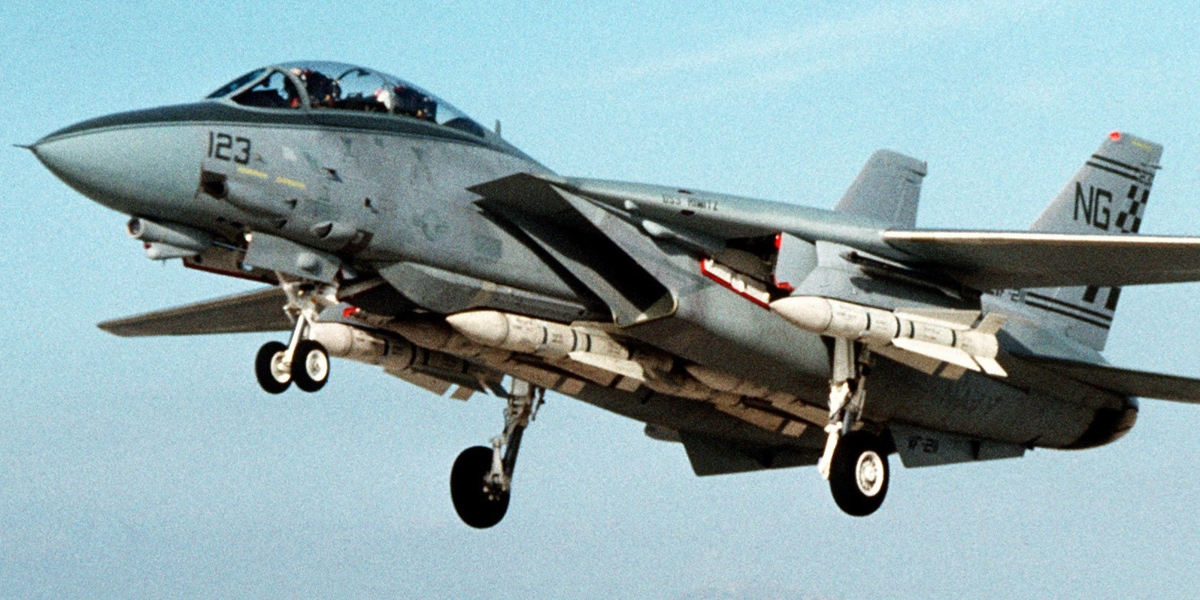
 theaviationgeekclub.com
theaviationgeekclub.com

US Navy F-14 crew members explain how you could land a Tomcat with a full load of six AIM-54 Phoenix missiles on the aircraft carrier - The Aviation Geek Club
US Navy F-14 crew members explain how you could land a Tomcat with a full load of six AIM-54 Phoenix missiles on the aircraft carrier
dark sidius
ACCESS: Top Secret
- Joined
- 1 August 2008
- Messages
- 1,200
- Reaction score
- 1,075
F-14 has nothing to see with NGAD
- Joined
- 16 April 2008
- Messages
- 9,619
- Reaction score
- 14,535
And Landing weight is far lighter, like I believe the Max is like 20 tons for carriers.
The new Advanced Arresting Gear is good for up to 55,000 lbs (27.5 tons, 25,000 kg). The old Mk7 is a bit less at 50,000 lbs (25 tons, 22,700 kg).
You also don't have to worry too much when several factors today are positively influencing the landing weight:
- F/A-XX structural weight fraction will be less than today achievements thanks to a better knowledge in design sciences (better material, better in-design simulations, better integration of systems...)
- Long range means more fuel hence a greater portion of it expended b/w takeoff and landing phases (the fuel reserve for landing fraction would be less than for a short range fighter)
- Generalized offload of weaponry on other aircraft and system (UAS, Distributed targeting etc...) and the miniaturization of weapons would mean that the bring back load would be less of a concern.
All in all, it would make the next generation naval fighter easier to integrate with the landing requirements.
- F/A-XX structural weight fraction will be less than today achievements thanks to a better knowledge in design sciences (better material, better in-design simulations, better integration of systems...)
- Long range means more fuel hence a greater portion of it expended b/w takeoff and landing phases (the fuel reserve for landing fraction would be less than for a short range fighter)
- Generalized offload of weaponry on other aircraft and system (UAS, Distributed targeting etc...) and the miniaturization of weapons would mean that the bring back load would be less of a concern.
All in all, it would make the next generation naval fighter easier to integrate with the landing requirements.
Last edited:
Avimimus
ACCESS: Top Secret
- Joined
- 15 December 2007
- Messages
- 2,430
- Reaction score
- 911
So... in terms of official NGAD, F/A-XX, and F-X concepts... are there any I'm missing?
Also - does anyone know of an attempt to draw profiles of the existing concepts? Or is everyone waiting until after the official competition completes? I haven't found any yet.
Also - does anyone know of an attempt to draw profiles of the existing concepts? Or is everyone waiting until after the official competition completes? I haven't found any yet.
Attachments
- Joined
- 1 April 2006
- Messages
- 11,402
- Reaction score
- 10,343
3 & 4 are not official onesSo... in terms of official NGAD, F/A-XX, and F-X concepts... are there any I'm missing?
Also - does anyone know of an attempt to draw profiles of the existing concepts? Or is everyone waiting until after the official competition completes? I haven't found any yet.
bring_it_on
I really should change my personal text
- Joined
- 4 July 2013
- Messages
- 3,679
- Reaction score
- 3,866
So... in terms of official NGAD, F/A-XX, and F-X concepts... are there any I'm missing?
The two from Lockheed (I think they've come out with two though there could be more). More if you want to include the art floated around by the likes of Raytheon, BAE and others.
Yeah the yf23 can't be beat in looks.This one is my personal favourite
dark sidius
ACCESS: Top Secret
- Joined
- 1 August 2008
- Messages
- 1,200
- Reaction score
- 1,075
It look to be for the Navy NGAD program, and we don't saw another picture of this one.View attachment 664220
Never worked out this one, posted as NG NGAD on ATS awhile back and no one commented on
Also - does anyone know of an attempt to draw profiles of the existing concepts? Or is everyone waiting until after the official competition completes? I haven't found any yet.
Attachments
- Joined
- 1 April 2006
- Messages
- 11,402
- Reaction score
- 10,343
Morning!Never worked out this one, posted as NG NGAD on ATS awhile back and no one commented on it.
- Joined
- 3 June 2011
- Messages
- 18,351
- Reaction score
- 12,274
That's not a YF-23. Aside from the butterfly tail there's nothing in common. May as well call a YF-23 a Beechcraft Bonanza.Yeah the yf23 can't be beat in looks.This one is my personal favourite
So is the thing at the front a canard or leading edge of the main wing?Morning!Never worked out this one, posted as NG NGAD on ATS awhile back and no one commented on it.
Avimimus
ACCESS: Top Secret
- Joined
- 15 December 2007
- Messages
- 2,430
- Reaction score
- 911
3 & 4 are not official onesSo... in terms of official NGAD, F/A-XX, and F-X concepts... are there any I'm missing?
Also - does anyone know of an attempt to draw profiles of the existing concepts? Or is everyone waiting until after the official competition completes? I haven't found any yet.
Makes sense. That particular tailless canard layout always felt wrong to me.
This one is my personal favourite
I always liked that layout - the McDD/Northrop/BAe JSF and Checkmate... but for a sixth generation design I'm hoping for a pure tailless/flying-wing design. This is one of the few places where the requirements and funding might be sufficient to produce a supersonic flying wing.
So... in terms of official NGAD, F/A-XX, and F-X concepts... are there any I'm missing?
The two from Lockheed (I think they've come out with two though there could be more). More if you want to include the art floated around by the likes of Raytheon, BAE and others.
Never worked out this one, posted as NG NGAD on ATS awhile back and no one commented on it.
Also - does anyone know of an attempt to draw profiles of the existing concepts? Or is everyone waiting until after the official competition completes? I haven't found any yet.
Thanks for the replies!
- Status
- Not open for further replies.
Similar threads
-
Japanese next generation fighter studies (aka i3, F-3)
- Started by bobbymike
- Replies: 575
-
CNO Greenert Warns Congress of Fighter Shortfall, Hornet Line to Close 2017
- Started by Triton
- Replies: 1
-
Russian 6th Generation Fighter News
- Started by bobbymike
- Replies: 41
-
-

